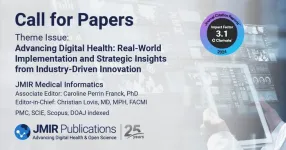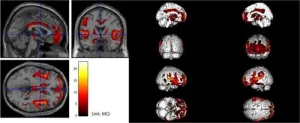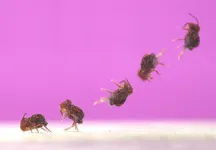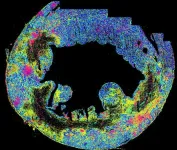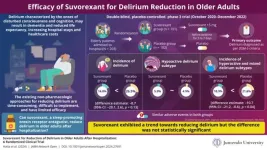(Press-News.org) A new study has found an answer for a long-lasting question in aging research - Is Alzheimer’s disease-dementia a form of accelerated aging or is there a different path that can lead us to healthier brain aging? In an international effort, the researchers mapped 1.65 million cells from 437 aging brains, and uncovered distinct paths of cellular change in the aging brains, with one leading to Alzheimer’s disease and the other to an alternative form brain aging. They also point to specific cell signatures predicted to advance disease once they appear in the aging brain. These findings offer new insights into the disease’s development and how it is different from healthy brain aging. As these changes in brain cells may occur many years prior to the development of symptoms and memory loss, this discovery opens the door to personalized prevention medicine that could alter disease progression and improve outcomes for individuals at risk.
[Hebrew University] A new study, published in Nature, led by an international team, including Dr. Naomi Habib and Gilad Green from the Hebrew University of Jerusalem, Dr. Philip L. De Jager and Dr. Vilas Menon from Columbia University Irving Medical Center, Dr. David Bennett from Rush Alzheimer’s Disease Center and Dr. Hyun-Sik Yang from Harvard Medical School, has uncovered crucial insights into the cellular dynamics that contribute to brain aging and the cellular events leading to the onset and progression of Alzheimer’s disease (AD). By creating one of the biggest resources in the brain aging field, mapping over 1.65 million cells from 437 aging brains, and developing new machine learning (AI) algorithms, the research team has revealed distinct cellular paths in brain aging, providing a foundation for personalized therapeutic development targeting Alzheimer’s disease.
Mapping Brain Aging: A Closer Look at Brain Cells
This study took an in-depth approach to map the brain’s cellular environment, analyzing a unique dataset of 1.65 million single-nucleus RNA sequencing profiles from the prefrontal cortex of 437 older adults in the ROSMAP cohort at Rush University in Chicago, IL, USA. With this large dataset, researchers were able to pinpoint specific glial and neuronal cell groups linked to traits related to Alzheimer’s disease (AD). Moreover, the study zeroed in on the complex dynamics within the brain cells along the progression of aging and disease, using a new algorithm called BEYOND to model these dynamics. This approach revealed two distinct paths of brain aging, each marked by gradual coordinated changes in distinct groups of cells, which the researchers termed as “cellular communities” in the brain. Interestingly, they showed that one of these paths leads to Alzheimer’s disease, gradually leading to dementia – featured by memory loss and cognitive decline, while the other represents a healthier, non-Alzheimer’s form of brain aging. The researchers predict that these cellular changes, that start early – before any clinical signs of dementia – are actively determining the fate of the aging brain and the progression of the disease.
Important Discoveries in Alzheimer’s Disease
Alzheimer’s disease is characterized by hallmark brain pathologies, with the classical Amyloid theory of AD describing the cascade of events thought to follow the progression of the disease – starting with the accumulation of amyloid-β plaques, which then lead to accumulation of toxic neurofilament tangles, eventually leading to substantial neuronal damage and symptoms of clinical dementia. Glial cells, such as microglia and astrocytes, are supportive cells that are critical for the correct function of the brain and of neuronal cells, yet have only been recently suggested to take part in the cascade leading to Alzheimer’s disease. For example, a previous article, published in Nature Neuroscience in 2023 led by the same team with Anael Cain a PhD student in the Habib lab, laid the scientific foundation for the findings on specific cellular communities and glial cells related to Alzheimer’s disease. A key discovery from this study is the identification of specific glial cells predicted to contribute to the progression of the disease. The current study uncovered two different subsets of microglial cells, both linked to altered lipid metabolism: one was predicted by the team to drive the buildup of amyloid-β plaques, the initial hallmark pathology of Alzheimer’s disease, while the other is predicted to drive the later buildup of neurofilament tangles. The team also highlighted a group of astrocyte cells that influence directly cognitive decline, shedding more light on the complex interactions between different brain cells in the progression of Alzheimer’s disease, and highlight the key role that glial cells are taking in the progression of the disease.
Impact on Personalized Treatment Development
"The insights from this research provide a fresh understanding of how Alzheimer’s disease develops, from the very early stages, which was not possible to measure without our large dataset and unique algorithmic approach", said Dr. Habib, "by identifying the specific cells involved in each unique path of brain aging, Alzheimer’s and alternative aging, we paved the way to early identification of people at risk of Alzheimer’s disease and for creating targeted treatments for each form of brain aging to promote healthy aging". The findings lay a cellular foundation for understanding the different paths leading to Alzheimer’s. This knowledge is vital for developing personalized treatments that can act at the cellular level, potentially changing the course of the disease.
END
New research unveils cellular pathways to Alzheimer’s and alternative brain aging
2024-08-29
ELSE PRESS RELEASES FROM THIS DATE:
JMIR Medical Informatics is inviting submissions for a new theme issue titled: "Advancing Digital Health: Real-World Implementation and Strategic Insights from Industry-Driven Innovation"
2024-08-29
Toronto- August 27, 2024 - JMIR Publications invites submissions to a new theme issue titled “Advancing Digital Health: Real-World Implementation and Strategic Insights from Industry-Driven Innovation” in JMIR Medical Informatics, a leading peer-reviewed journal indexed in PubMed with a unique focus on clinical informatics and the digitization of care processes.
The health care landscape is transforming rapidly, driven by technological innovation and the pressing need for more efficient, accessible and patient-centric health care solutions.
Yet, the health IT industry grapples with ...
Terasaki Institute scientist awarded 2024 NARSAD Young Investigator Grant
2024-08-29
LOS ANGELES, August 29, 2024 — Yangzhi Zhu, Ph.D., Assistant Professor at the Terasaki Institute for Biomedical Innovation (TIBI), has been awarded the prestigious 2024 NARSAD Young Investigator Grant for his groundbreaking work on a lab-on-a-contact lens (LoCL) system. This innovative technology is designed to monitor mental health by providing real-time, non-invasive tracking of panels of key biomarkers, from the wearer’s tears.
Mental health disorders, such as anxiety and depression, affect nearly a billion ...
A breakthrough in diagnosing hydrocephalus: Multimodality approaches enhance accuracy and reduce costs
2024-08-29
A recent case report published in Cyborg Bionic Systems details the diagnosis of Idiopathic Normal Pressure Hydrocephalus (iNPH) using multimodality diagnostic approaches, highlighting significant advancements in medical diagnostics and patient care. The study conducted by a team of researchers from Tianjin Medical University General Hospital, Tianjin, China, presents a comprehensive case study of a 68-year-old male patient diagnosed with iNPH, showcasing the effectiveness of these advanced diagnostic techniques.
iNPH is a condition characterized by the accumulation of cerebrospinal fluid (CSF) causing ventricular dilation, ...
This tiny backyard bug does the fastest backflips on earth
2024-08-29
Move over, Sonic. There’s a new spin-jumping champion in town – the globular springtail (Dicyrtomina minuta). This diminutive hexapod backflips into the air, spinning to over 60 times its body height in the blink of an eye, and a new study features the first in-depth look at its jumping prowess.
Globular springtails are tiny, usually only a couple millimeters in body length. They don’t fly, bite or sting. But they can jump. In fact, jumping is their go-to (and only) plan for avoiding predators. And they excel at it – to the naked eye it seems as though they vanish entirely when they take off.
“When globular springtails ...
Climate change increases foodborne illness risk from raw produce
2024-08-29
Highlights:
Salmonella enterica causes disease in 1.2 million people in the U.S. annually.
The most common way people get infected is by consuming contaminated fresh produce.
New research shows that bacterial leaf spot of lettuce and high humidity promote S. enterica growth in lettuce, and climate change is predicted to increase humid periods.
Washington, D.C.—Climate change will increase the risk of the foodborne illness from Salmonella enterica, according to a new study. The research was published today in Applied and Environmental Microbiology, a journal of the American Society for Microbiology.
S. enterica causes disease in 1.2 million people in the ...
NSF Grant empowers FAU to explore Caribbean climate crisis with ethnography
2024-08-29
Transformations in the global climate system are profoundly destabilizing ecosystems across the Caribbean, with South Florida and Puerto Rico experiencing notable impacts. To address this challenge, researchers from Florida Atlantic University and the University of Puerto Rico (UPR) in Cayey, are turning to ethnography – an in-depth, immersive research method that involves observing and interviewing people in their natural settings.
FAU’s Dorothy F. Schmidt College of Arts and Letters, in collaboration with UPR Cayey, has received a $650,000 grant from ...
A bacterial defense with potential application in genome editing
2024-08-29
COLUMBUS, Ohio – Scientists who have described in a new study the step-by-step details of a bacterial defense strategy see the mechanism as a promising platform for development of a new genome-editing method.
The system involves two proteins that team up to disable plasmids, small DNA molecules that exchange genetic information among different bacterial strains. While plasmids provide evolutionary benefits, they can also be seen by host bacteria as threats.
The research team determined that one protein uses a short piece of DNA – known as a DNA guide – to ...
Labor day crowds temporarily impact local streams, research shows
2024-08-29
Crowds flocking to rivers and streams over Labor Day weekend are doing more than cooling off and having fun. They’re temporarily introducing chemicals and microscopic organisms into their local waterways, according to new research from Johns Hopkins University.
The research, published today in ACS ES&T Water, is the first holistic assessment of how recreation impacts streams. Findings also provide insight into the compounds and chemicals people are splashing around in when their favorite swimming spots are packed.
“Residue from ...
Borderzone Breakthrough: A new source of cardiac inflammation
2024-08-29
Ischemic heart disease is the most common cause of death in the world. It begins with a “heart attack”, also known as a myocardial infarction (MI), which causes part of the heart to die due to inadequate coronary blood flow. This leads to vigorous inflammation, heart wall remodeling, and heart failure.
Anti-inflammatory drugs have been surprisingly ineffective at preventing heart failure. As a consequence, they are not a routine part of post-MI care. However, it is possible that the most potent molecular and cellular inflammation targets have yet to be discovered.
In the Aug. 28, ...
New study assesses the efficacy of suvorexant in reducing delirium in older adults
2024-08-29
Delirium is a sudden onset and temporary state of disturbed consciousness or cognition, occurring due to underlying medical issues like fever or alcohol withdrawal. It is most common among older hospitalized adults aged 75 years or above, leading to increased risk of falls, dementia, low life expectancy, and high healthcare expenses.
Non-pharmacological approaches to prevent or reduce delirium are time-consuming, hard to implement, and partially effective. So, pharmacological interventions offer hope. Insomnia, a significant risk factor for delirium, could be alleviated with sleep-promoting medications. However, not all ...
